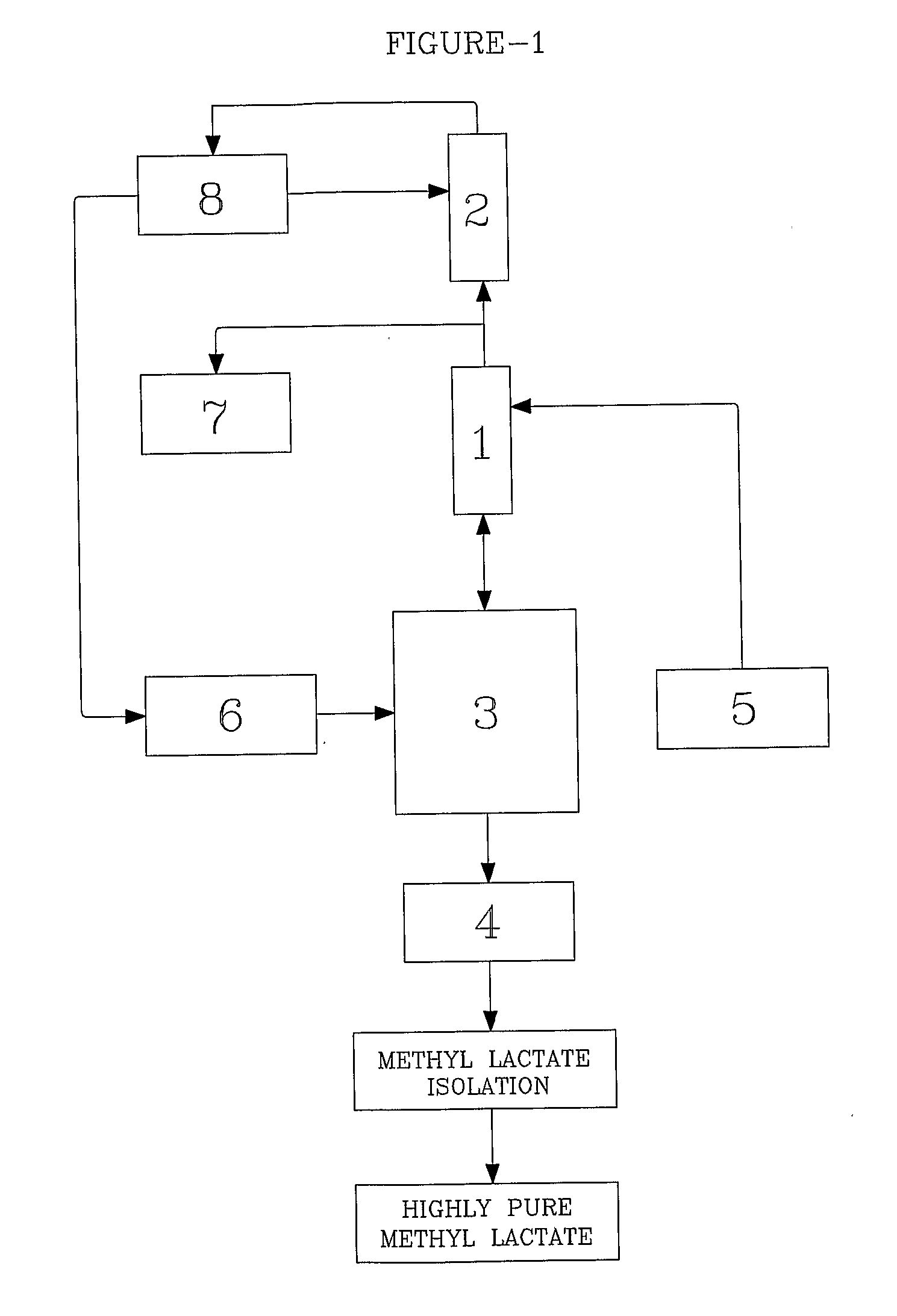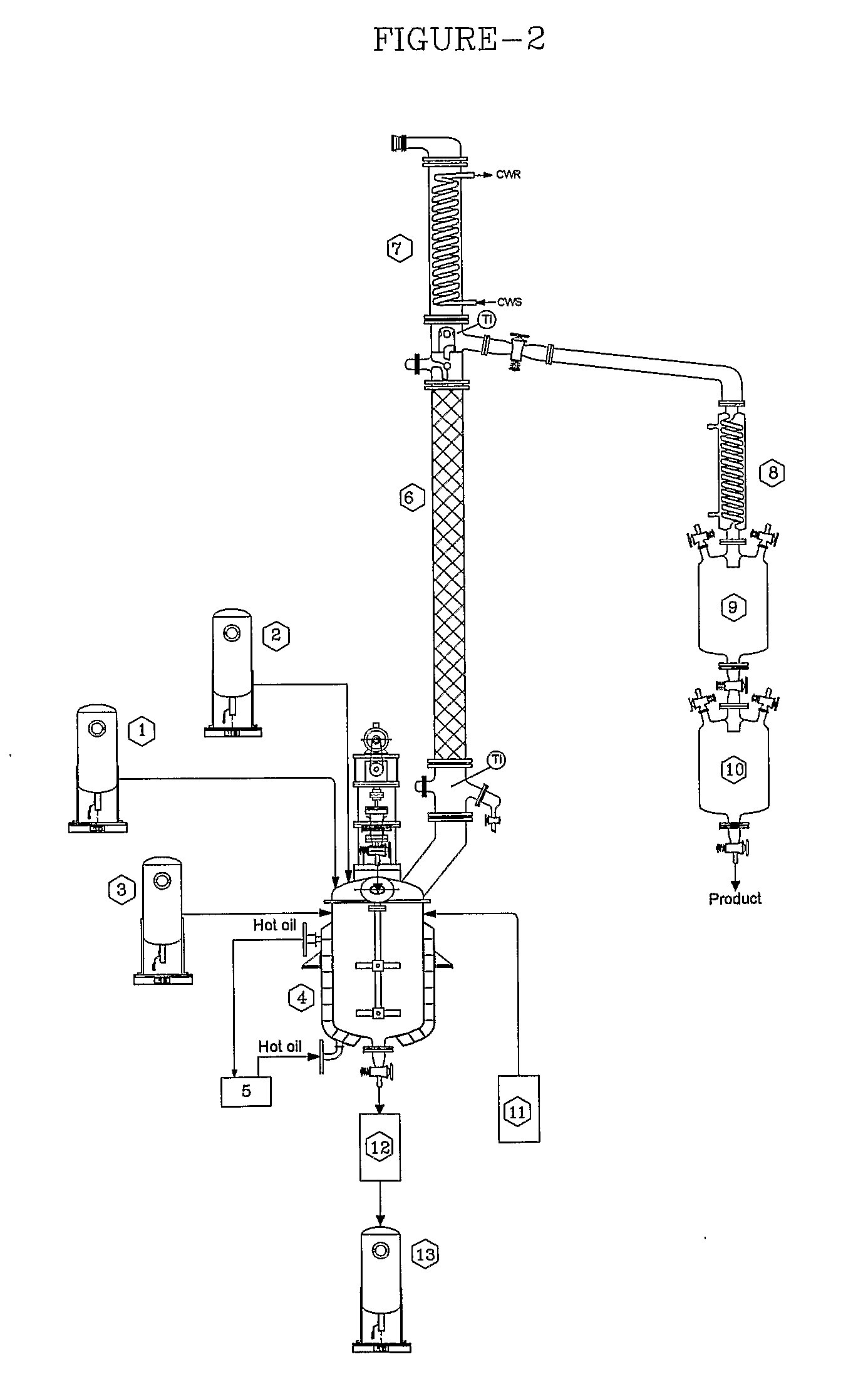Process for preparing l- (+) -lactic acid
a technology of lactic acid and process, which is applied in the preparation of carboxylic acid esters/lactones, chemistry apparatus and processes, and organic chemistry, etc. it can solve the problems of high operating cost of recovery at industrial scale of manufacture, high capital investment on recovery, and low lactic acid to its ester. , to avoid the polymerization and oxidation of lactic acid
- Summary
- Abstract
- Description
- Claims
- Application Information
AI Technical Summary
Benefits of technology
Problems solved by technology
Method used
Image
Examples
example-1
Preparation of Crude Lactic Acid Feed Stock
[0054]The glass lined stirred reactor having capacity of 20 L, was charged 10% by wt solution of calcium lactate in water, obtained from fermentation of sugar cane juice. Then to the calcium lactate solution in water, 50% by wt sulfuric acid in water Was charged in a stoichiometric ratio to release free lactic acid slowly within 1-hour maintaining temperature at 30° C. The reaction mixture after further stirring for 60 minutes was filtered on the centrifuge. The wet cake of calcium sulfate was washed with water to remove adhered acidity. The wet cake of calcium sulfate was dried at 110° C. to give white calcium sulfate. The filtrate and washing were concentrated on the falling film evaporator under vacuum to get crude lactic acid. The crude lactic acid so obtained was viscous, dark reddish brown liquid and had impurities of fermentation. It was treated with activated charcoal and filtered to get transparent and clear crude lactic acid in wa...
example-2
Esterification Using Trickle Phase Continuous Counter Current Method
[0055]Referring drawings accompanying this specification, FIG. 1 represents the setup of this present invention mentioned.
[0056]Dilute crude lactic acid prepared as explained in Example-1 was pre-mixed with concentrated sulfuric acid (1 mole % of lactic acid) and stored in tank (5). Crude lactic acid feed was continuously pumped through pre-heater at 960 g / h. The temperature of pre-heater was maintained by hot oil circulator so as to maintain crude lactic acid feed temperature at 96° C. The heated crude lactic acid was fed continuously at slightly above the mid of trickle phase reactive distillation section (1) column fixed above the reboiler (3). Fresh methanol containing 0.4% water was stored in methanol feedstock tank (6). This methanol was continuously pumped through pre-heater at 720 g / h. The pre-heater temperature was maintained by hot oil circulator so as to get superheated methanol vapors at 82° C. The super...
example-3
Esterification Using Trickle Phase Continuous Counter Current Method
[0060]Referring drawings accompanying this specification, FIG. 1 represents the setup of this present invention mentioned.
[0061]Crude lactic acid prepared as explained in Example-1 was pre-mixed with concentrated sulfuric acid (1 mole % of lactic acid) and stored in tank (5). This crude lactic acid mixture was continuously pumped through pre-heater at 960 g / h. The temperature of pre-heater was maintained by hot oil circulator so as to maintain crude lactic acid feed temperature at 107° C. The heated crude lactic acid was fed continuously at the mid of trickle phase column section (1), fixed just above re-boiler (3). Fresh methanol feedstock containing 0.4% water was stored in tank (6) This methanol was continuously pumped through pre-heater at 720 g / h. The pre-heater temperature was maintained continuously by hot oil circulator so as to get superheated methanol vapors at 155° C. The superheated methanol vapors were ...
PUM
| Property | Measurement | Unit |
|---|---|---|
| temperature | aaaaa | aaaaa |
| temperature | aaaaa | aaaaa |
| optical purity | aaaaa | aaaaa |
Abstract
Description
Claims
Application Information
 Login to View More
Login to View More - R&D
- Intellectual Property
- Life Sciences
- Materials
- Tech Scout
- Unparalleled Data Quality
- Higher Quality Content
- 60% Fewer Hallucinations
Browse by: Latest US Patents, China's latest patents, Technical Efficacy Thesaurus, Application Domain, Technology Topic, Popular Technical Reports.
© 2025 PatSnap. All rights reserved.Legal|Privacy policy|Modern Slavery Act Transparency Statement|Sitemap|About US| Contact US: help@patsnap.com


